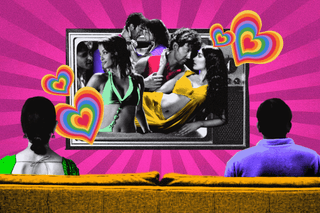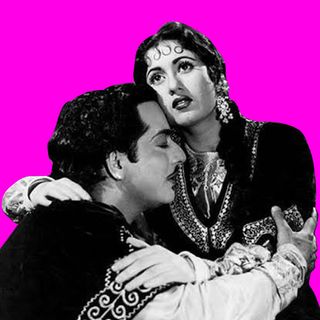
Bollywood’s Soul Resided in Its Love Stories. Are They Disappearing?
Bollywood’s trademark romances are disappearing from screens in service of hypermasculinity and religious fervor, endangering the escapist fantasy that classic love stories offered audiences for decades.

India’s obsession with love stories is a matter of fact. For decades, the Hindi film industry has refused to lean away from the formula of love, even while producing movies in the genres of action, crime, fantasy, sci-fi, or historical fiction. In a culture that aggressively endorses arranged marriages, it is Bollywood that nurtures the romantic within most Indians. Netflix’s recent docu-series The Romantics, too, highlights the obsession that both Bollywood’s filmmakers and its audience has with love stories. It is, to a great extent, the mass appeal of love that catapulted Yash Raj Films — the subject of the documentary — to the rank of one of Bollywood’s leading production houses.
Today, however, despite most movies continuing to embed romances somewhere in the script, there’s a marked rise of narratives rooted in nationalism and chauvinistic machismo. In this magnum opus era of Indian cinema, Bollywood’s trademark romances have receded from our screens to make space for hypermasculinity and religious fervor, endangering the escapist fantasy that Bollywood has offered its audiences for decades and relegating love to a mere plot device.
The rise in the new hypermasculine, hyper-religious flavor of storytelling in Indian cinema is embodied in the posters of the biggest films today. That of the recent blockbuster, Pathaan — ironically, helmed by India’s favorite romantic lead, Shah Rukh Khan — features its cast members mid-action, armed with guns. The poster of the 2022 hit RRR, currently the face of mainstream Indian cinema internationally, features its buffed-up lead duo, Ram Charan and N.T. Rama Rao Jr., flexing their muscles as they aim arrows and spears at their enemies. Ram Charan, here, is even dressed to look similar to the Hindu deity, Ram. Similarly, the poster of Brahmastra: Part One – Shiva — Bollywood’s most expensive movie ever — features its male lead, Ranbir Kapoor, holding a trishul (trident) as he portrays a modern reimagining of the Hindu deity Shiva.
In its endeavor to cater to the growing religious and jingoistic fervor in India, the formula denies audiences the escapist fantasy of a sweet, innocent love story. In a country struggling with unhappiness, romantic comedies have soothed and healed its people for generations, which is precisely what made Shah Rukh (the “king of romance”) a reigning superstar. “Media has always been a form of escape for many — to get away from reality and its burdens,” notes Anushree Aurangabadkar, a psychotherapist from Nagpur, explaining how the desire to indulge in romantic fantasies — as a means of escapism or otherwise — is an innately human tendency. “This need comes from multiple things: procreation, safety, belongingness… Humans love love.”
Unlike a thriller, a magical fantasy, or a nationalistic script that might not be everyone’s cup of tea, a love story has a universal appeal, according to Varun Grover, a writer with Masaan, Sacred Games, and Sandeep Aur Pinky Faraar to his credit. “Every story needs an emotional engine,” he says.
Related on The Swaddle:
The Stereotype That Abusers Are ‘Bad’ People Can Prevent Survivors From Recognizing Real‑Life Abuse
But beyond escapism, indulging in romances vicariously through our favorite on-screen couples is an emotional necessity too, especially within the cultural milieu of India, where love is restricted within caste, class, and gender barriers, and attempts to break free are often met with retribution in the form of honor killings and public assaults. Thus, with real-life denying a multitude of Indians their shot at romance, Bollywood has always opened its arms to them — in the signature style of Shah Rukh — allowing them to bask in the glory of their romantic fantasies, albeit temporarily. “The only healthy way [for many Indians] to meet these needs is the world of outrageously flimsy fiction and cheesy love poetry and lyrics,” writes Soma Das, a columnist with a master’s in clinical psychology.
The rise of testosterone-fueled nationalist cinema is also diminishing the roles of women — often reducing them simply to sex objects, love interests, or any other plot device that serves to further the narrative of the leading men. With the exception of Pathaan, almost all of India’s successful box office outings recently — including Pushpa, Brahmastra, and Sooryavanshi — attest to this. Pathaan’s makers granted Deepika Padukone, its female lead, her own agency and narrative arc, but in almost every other movie within this genre, women are reduced to being plot devices guiding the male leads to their heroic destinies, propelling their narrative arc of righteous revenge, or simply, playing the stereotypical love interest that holds them back from their nationalistic duties.
This isn’t to say that Bollywood’s romantic films were, in any way, pinnacles of feminism. In fact, they have been routinely criticized for normalizing stalking, endorsing toxic relationships, and presenting gender violence as an expression of love, loyalty, and passion. But the female characters in these films were, arguably, more fleshed out, and allowed more of a modicum of agency than the current formula allows.
Arguably, it was the success of Baahubali: The Beginning in 2015 that set the standard for the new era of glorification of hypermasculinity and violence on-screen. Soon, nationalism was introduced to the mix. Every subsequent successful movie that abided by this formula inspired more and more filmmakers to capitalize on the trend, especially with the recent string of pan-Indian movies like RRR, KGF, Vikram, Shamshera,and Liger joining the club.
In the meantime, the relative failure of movies like ’83 and Laal Singh Chaddha, which didn’t subscribe to the hypermasculine formula, has bolstered producers’ inclination to stick to it. The popularity of the genre has also pushed movies delving into the intricacies of romance — like Gehraiyaanand Darlings— to the niche domain of OTT platforms, despite them being led by bankable stars.
Related on The Swaddle:
How Pop Culture Paints an Unhealthy, Unsustainable Picture of Friendships
Further, the normalization of men’s emotional vulnerability that Shah Rukh introduced to Bollywood through his characters, challenging the trope of the “angry young man,” is lost in the land of men expressing repressed emotions through choreographed fight scenes. Unlike his earlier hits like Kuch Kuch Hota Hai (1998) and Kabhi Alvida Naa Kehna (2006) — or more recent ones like Chennai Express (2013) and Zero (2018) — Paathan, relied on Shah Rukh’s muscles rather than his emotiveness to attract audiences. In a country that continues to struggle with the ramifications of toxic masculinity, both in terms of its crime rates and the deteriorating mental health of its male citizens, this fixation on hypermasculinity is worsening the burden.
Before hypermasculine nationalism took over Bollywood, romances had begun to evolve both their characters and narratives — even if their pace and content weren’t yet perfect. Movies like My Name Is Khan (2010), Margarita With a Straw (2014), and Sairaat (2016) symbolized progress by showcasing stories of love uniting couples across the barriers of religion, heteronormativity, caste, and class. Bollywood had also been pivoting from urban romances to romantic comedies set in small towns, challenging the largely homogenous culture of metros that frequently featured in earlier movies and making way for diverse languages, cultures, and conflicts to dominate narratives. Ushering an era of relatively honest representations of human lives on screen, small-town romances reflected the aspirations and challenges of middle-class Indians from oft-ignored parts of the country — laying a foundation for bridging the urban-rural mindset gap. The current slew of big-budget action movies, however, with their culturally ambiguous leads flexing their muscles in culturally ambiguous big cities, has snatched away the wholesome space that small-town romances had carved in our lives.
Through its love stories, Bollywood has nurtured our humanity for decades — laying the bricks for a brighter, more inclusive future for love. Grover believes our love for romance reveals that “despite our stance against people choosing love on their own terms in real life, we are still humane enough to be swayed by the possibilities of love on screens.”
Indeed, cinema, as a medium, can be a powerful instrument of change. Rashi Bhargava, an assistant professor of sociology at Christ (deemed to be) University in Bengaluru, believes it is possible that watching diverse representations of love — queer, inter-caste, inter-faith — playing out on screen and being invested in the characters’ journeys, can inspire changes in people’s mindsets when it comes to approaching such couples in real life.
As such, love stories are, perhaps, the last frontier against the dominant jingoistic narrative.
Devrupa Rakshit is an Associate Editor at The Swaddle. She is a lawyer by education, a poet by accident, a painter by shaukh, and autistic by birth. You can find her on Instagram @devruparakshit.
Related


Social Media Is Enabling Fans to Manufacture Celeb ‘Catfights’ Based on Likes, Follows
